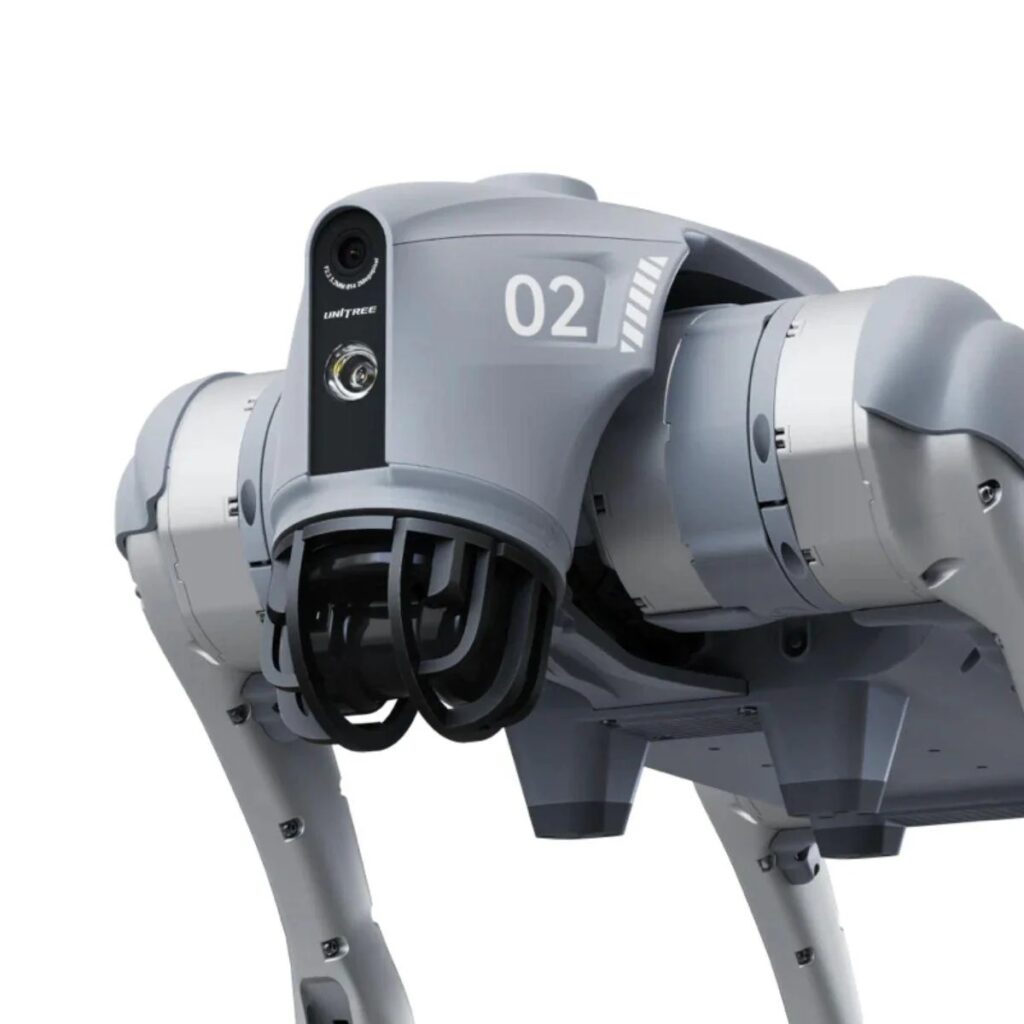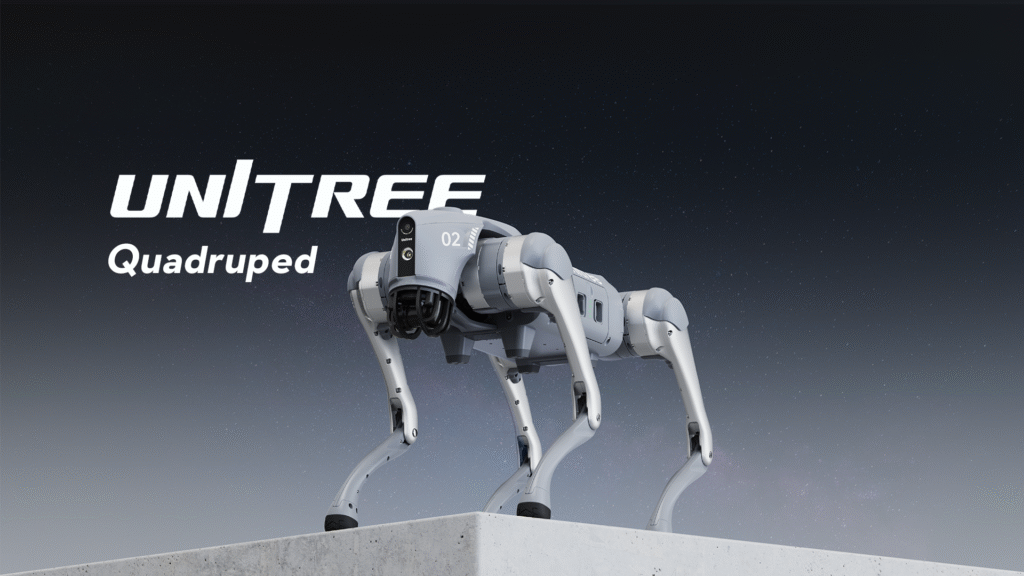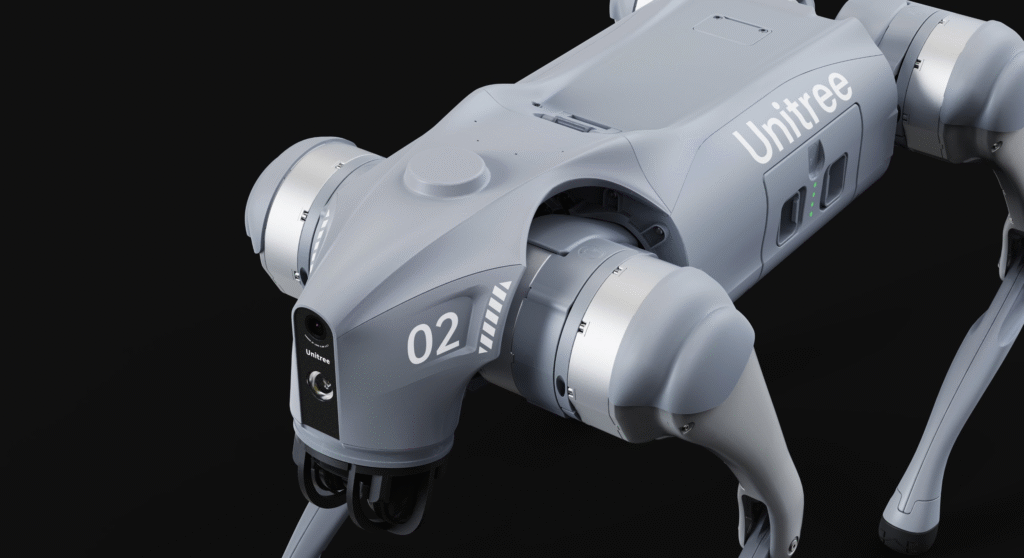Meet the Future of Mobility: Unitree Quadruped Robots
The future of robotics is no longer limited to drones in the sky — it’s taking confident steps on the ground.
At Dronevex, we are redefining the boundaries of innovation with our state-of-the-art Unitree Quadruped Robots — machines that are not only intelligent and agile but also engineered to tackle real-world challenges with precision and reliability.
These next-generation robots are a perfect blend of mechanical engineering, artificial intelligence, and bio-inspired design, allowing them to move with unparalleled stability, navigate complex terrains, and respond autonomously to dynamic environments. From conducting detailed industrial inspections and enhancing security operations to supporting research, education, and entertainment, these quadrupeds bring a new level of mobility, adaptability, and operational efficiency. Their ability to mimic the fluid, adaptive motion of living creatures sets a new benchmark for robotics, enabling tasks that were previously considered impossible for conventional machines.
What Are Quadruped Robots?
Quadruped robots, often referred to as “robot dogs,” are four-legged robotic platforms designed to move and respond much like real animals. Their advanced design gives them superior balance, agility, and terrain adaptability compared to traditional wheeled or tracked robots.
Equipped with AI-powered navigation, 3D LiDAR mapping, and real-time obstacle detection, these robots can operate in challenging and dynamic environments — both indoors and outdoors. Their capabilities include:
Recovering from slips or falls
Climbing slopes and stairs
Maneuvering through uneven and debris-filled surfaces
These abilities make quadrupeds invaluable for missions where humans or conventional machines face safety risks or operational limitations.
Why Quadruped Robots Are the Future
At Dronevex, we view quadruped robots not just as tools but as autonomous partners capable of enhancing efficiency, safety, and operational scope. Here’s why they are transforming industries:
- Unmatched Agility and Stability: With four-legged locomotion, Unitree quadruped robots maintain balance on rough surfaces, staircases, and debris-laden environments, ensuring reliable performance in unpredictable operational conditions — from factories and warehouses to construction sites and mines.
- Advanced Smart Autonomy: Integrated AI and perception systems allow the robots to map surroundings in 3D, detect objects, and make real-time decisions. They can operate autonomously or under remote supervision, adapting dynamically to new challenges.
- Versatility Across Industries: Unitree quadruped robots are highly modular, supporting payloads such as LiDAR scanners, high-definition cameras, robotic manipulators, and environmental sensors. They are deployed across a range of applications, from industrial inspections and security operations to research laboratories and educational institutions.
- Efficiency and Endurance: Designed with high-capacity batteries and intelligent power management, Unitree quadruped robots can perform extended missions in remote or high-demand environments, minimizing downtime and maximizing operational output.
Dronevex: Unitree Quadruped Lineup

We bring you a carefully curated selection of Unitree quadruped robots, each optimized for specific tasks and environments:
Unitree Go2 Series (Air / Edu / Ent Models)
Compact, intelligent, and ideal for R&D, educational programs, and light industrial applications.Unitree Go2 Pro / EDU U Series
Equipped with advanced AI computing, multi-sensor suites, and enhanced autonomy for research, testing, and professional deployment.Unitree B2-W (Industry Grade with 3D LiDAR)
Built for high-demand field operations, offering exceptional speed, load capacity, and environmental awareness.Unitree Go2 ENT U5 / U6 Series
Enterprise-grade platforms for security, logistics, and inspection missions, delivering durability, reliability, and long-term operational performance.
Each model comes with specific capabilities including payload options, walking speed, sensor packages, autonomy features, and software ecosystem compatibility.
Key Advantages of Dronevex Unitree Quadruped Robots
| Feature | Advantage |
|---|---|
| AI-Driven Autonomy | Advanced navigation, obstacle avoidance, and adaptive route planning |
| All-Terrain Mobility | Walks, runs, climbs, and maneuvers over obstacles with unmatched stability |
| 3D LiDAR & Vision Sensors | Real-time mapping, localization, and environment perception |
| Custom Payload Integration | Flexible addition of cameras, sensors, or robotic modules |
| Extended Battery Life | Supports long-duration missions with efficient power management |
| Rugged Industrial Build | Withstands dust, vibration, and harsh environmental conditions |
Applications Across Sectors
Unitree quadruped robots are transforming how industries, institutions, and organizations operate by providing unmatched mobility, intelligence, and adaptability. Their versatility allows them to tackle tasks that are dangerous, repetitive, or difficult for humans and traditional machines. Here’s a closer look at their key applications:
Industrial Inspections
Unitree quadrupeds are revolutionizing industrial inspections by carrying high-precision sensors, LiDAR scanners, thermal cameras, and environmental monitoring tools. They can navigate complex factory floors, power plants, pipelines, and hazardous sites, collecting data with extreme accuracy while keeping human operators out of harm’s way.
Whether detecting equipment anomalies, heat leaks, corrosion, or structural issues, these robots enable preventive maintenance, reduce downtime, and enhance operational safety. Their ability to traverse tight spaces, stairs, and uneven terrain allows inspection in areas previously inaccessible without scaffolding or human risk.
Security and Surveillance
Quadruped robots bring autonomous patrolling and surveillance to a new level. Equipped with 360-degree cameras, motion detection, and real-time alert systems, they can monitor large industrial complexes, campuses, warehouses, and public spaces around the clock.
Their agility allows them to navigate obstacles, stairs, and confined areas, while AI-driven analytics help identify unusual activity, intruders, or safety hazards. By combining mobility, autonomy, and intelligent monitoring, these robots augment human security teams, ensuring continuous, reliable, and proactive protection.
Research and Education
Universities, laboratories, and research institutions are leveraging Unitree quadrupeds as flexible, programmable platforms for robotics experimentation. Researchers can test advanced locomotion algorithms, AI vision models, swarm robotics, and autonomous decision-making in a controlled, real-world environment.
Open SDK and ROS compatibility allows students and researchers to develop custom modules, simulation experiments, and AI training programs, providing hands-on experience with state-of-the-art legged robotics technology. These robots serve as an essential bridge between theoretical learning and practical application.
Construction and Logistics
In large-scale facilities, warehouses, or construction sites with uneven terrain, Unitree quadrupeds excel at transporting tools, materials, and sensor payloads. Their four-legged design allows them to climb stairs, maneuver over debris, and access tight spaces where wheeled robots or humans may struggle.
This capability enables efficient supply transport, site inspection, and monitoring, reducing manual labor requirements and accelerating workflow. In logistics, quadrupeds can autonomously navigate facilities, deliver packages or instruments, and optimize operational efficiency without human intervention.
Search and Rescue Operations
Unitree quadrupeds are invaluable in disaster response and emergency scenarios. They can traverse rubble, debris, collapsed structures, or narrow passages to locate survivors and assess environmental risks.
Equipped with thermal imaging cameras, LiDAR mapping, and real-time communication modules, these robots provide rescue teams with critical situational awareness. They reduce human exposure to dangerous conditions, increase search coverage, and enable faster, data-driven decision-making during life-saving operations.
The Road Ahead
As automation continues to evolve, Unitree quadruped robotswill play a central role in creating safer, smarter, and more efficient operations. Their autonomous capabilities, environmental perception, and mobility make them a cornerstone of next-generation robotics.
The future isn’t just about flying drones — it’s about robots confidently walking on four legs.
🚀 Explore the full range of Dronevex Unitree Quadruped Robots here:
👉 https://dronevex.in/quadraped-robots/
Watch Unitree Quadruped Robots on our Youtube channel:
FAQ's
What terrains can Unitree Quadruped Robots navigate?
Unitree quadrupeds can walk, climb, and maintain stability on rough outdoor terrain, stairs, uneven factory floors, debris-filled areas, and confined indoor spaces, making them ideal for environments where wheeled robots fail.
How do these robots maintain balance when moving over obstacles?
They use advanced IMU sensors, dynamic control algorithms, and AI-driven gait adjustment to stabilize their legs in real time, allowing them to recover from slips, jumps, or uneven surfaces.
Can Unitree Quadruped Robots map environments in real-time?
Yes. Integrated 3D LiDAR and stereo cameras allow these robots to create high-precision maps of indoor and outdoor environments, detecting obstacles and planning autonomous routes on the fly.
What types of sensors are included in Unitree robots?
Depending on the model, sensors may include LiDAR, RGB cameras, depth sensors, IMUs, ultrasonic range finders, thermal cameras, and environmental monitors — enabling applications from inspection to surveillance.
How customizable are the payloads on Unitree Quadrupeds?
Payloads are modular — you can add robotic arms, cameras, LiDAR units, environmental sensors, or specialized instruments based on mission needs, making them highly adaptable across industries.
Are Unitree Quadrupeds suitable for fully autonomous missions?
Yes. Using AI-based path planning and autonomous navigation, they can operate without human input in structured or semi-structured environments. For complex or high-risk missions, they can also be remotely controlled.
How fast can Unitree Quadruped Robots move?
Walking speeds vary by model: smaller Go2 models move at 2–3 m/s, while industrial-grade B2-W quadrupeds can reach up to 3.5–4 m/s on flat terrain, with adaptive gait adjustment for obstacles.
Can these robots operate in harsh weather or industrial conditions?
Yes. Many models are designed for dusty, slightly wet, or vibration-heavy environments, making them suitable for industrial inspections, construction sites, and outdoor research missions.
How do Unitree Quadrupeds assist in search and rescue?
Equipped with thermal imaging, LiDAR mapping, and obstacle detection, they can navigate collapsed structures or debris, locate survivors, and transmit real-time data to rescue teams — reducing human risk in dangerous zones.
What software platforms do Unitree Quadrupeds support?
They are compatible with Unitree’s SDK, ROS (Robot Operating System), and Python APIs, allowing integration with custom algorithms, AI perception modules, and mission planning software for research or enterprise deployments.


